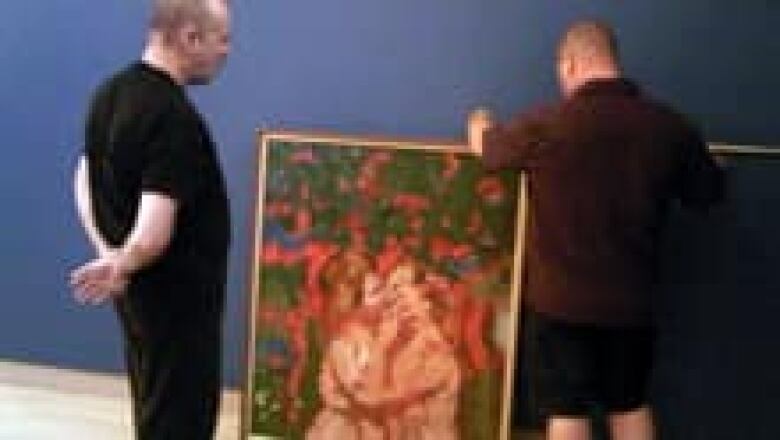Legendary war artist Bruno Bobak dies at age 88
He was Canada's youngest war artist during WW II

New Brunswick's arts community is mourning the loss of legendary Canadian war artist Bruno Bobak.
Bobak, of Fredericton, died Monday night at the Saint John Regional Hospital after being diagnosed with throat cancer earlier this summer.
He was 88.
Bobak was painting as recently as last winter, having contributed a large canvas to the Aspects of Fredericton exhibition at Gallery 78.

"He was a treasure to the whole province. People in Fredericton, or New Brunswick, will not be the same from now on," said gallery owner Inge Pataki, who collected and sold Bobak's paintings and was a close friend.
"He had an incredible dry humour, and very interesting to talk to because the field of conversation was just borderless. So I remember very fondly interesting and animated conversations at the dinner table. He was a wonderful man to know," she said.
On Tuesday, staff at the Beaverbrook Art Gallery in Fredericton were busy hanging in tribute three of his best-known works, called The Seasons, which depict him and his wife Molly Lamb during the seasons of their life.
Gallery director Bernie Riordon, who wrote a book on Bobak's career, said his paintings of people are particularly memorable.
'He was an iconic figure who had a real strong sense of place and time and who made a special contribution, not only in New Brunswick but to the Canadian art scene.' —Bernie Riordon, Beaverbrook Art Gallery director
"He painted them not only to see into them, but to see through them. He had a special X-ray vision — he captured the spirit and the essence of the sitters."
Riordon describes Bobak as one of the country's greatest artists and a national icon.
"He affected a lot of artists. He influenced a lot of collectors. He was an iconic figure who had a real strong sense of place and time and who made a special contribution, not only in New Brunswick but to the Canadian art scene," he said.
Riordon, who knew Bobak well, not only as a painter, but also as a friend and fishing companion, said he left a lasting legacy beyond his paintings.
"He was relaxed, he was kind, generous. He was a true lover of the salmon, and a great respect for the landscape and for the wilderness. A true environmentalist, and just a very kind, gentle, and passionate, and humanist person," Riordon said.
Attributed to success to war art

Bobak and his wife, Molly Lamb, were both enlisted by the federal government to detail its efforts in the Second World War after placing first and second in an art competition in 1944.
Bobak, who was only in his early 20s, was the country's youngest war artist.
"I wasn't old enough to go into a beer parlour, but I was old enough to be killed," he told CBC News during a 2006 interview.
Bobak had recently graduated from art school in Toronto when he joined the army as part of the Royal Canadian Engineers.
It was a time that Bobak said helped contribute to his success.
"Had the war not appeared when I was 19 years of age, I probably would still be struggling for recognition," he told CBC News in 2003.
According to the Military Museums' website, Bobak also reflected that becoming a war artist may have saved his life because most of the company he had been with was killed during their first day in Europe.
Bobak documented war scenes in Belgium, Holland and France, including Normandy.
In a 2002 interview with the CBC, he described the dual role of the war artist.
"There are two ways of looking at war art. One is a historical thing, and the other is a personal creative thing. And actually being a war artist combines the two," he said.
"Either you're making a document, or you're also trying to express yourself as an individual."
In 2006, Bobak told CBC News he was happiest when he was fishing and gardening, but he was also proud of his legacy as a painter.
"Being well-recognized as an artist is something that I'm happy about and [I'm] hoping to leave a small mark, or any kind of mark, enriching the cultural life of the country," he said.
Numerous prestigious awards

Bobak was born in Wawelowska, Poland and emigrated to Canada in 1927.
He began studying art at the age of 13 in Toronto under Arthur Lismer, a member of the Group of Seven and subsequently studied under future war artists, such as Carl Schaefer and Charles Goldhammer.
Bobak and his wife moved to Fredericton in 1960 after he was appointed artist-in-residence at the University of New Brunswick in 1960.
Bobak also served as the director of the UNB Art Centre from 1962 until his retirement in 1986.
During that time, Bobak became more versatile and well-known for his landscapes, prints and large oil paintings of the human body.
He received several prestigious awards and honours over the years, including being named a Member the Order of Canada in 1995, along with his wife.
"Their energy and enthusiasm as teachers, fund-raisers and arts advocates have helped create a climate for artistic and cultural growth in New Brunswick and earned them the respect of the academic world and the community beyond," according to a statement by the Governor General of Canada.
Bobak's works are found in collections across Canada.
Many of his war paintings are part of the collection at the Canadian War Museum in Ottawa.
Bobak participated in more than 250 group exhibits and had more than 80 one-man shows around the world.
Corrections
- A previous version of the story incorrectly stated where Bruno Bobak died.Oct 04, 2013 3:33 AM AT